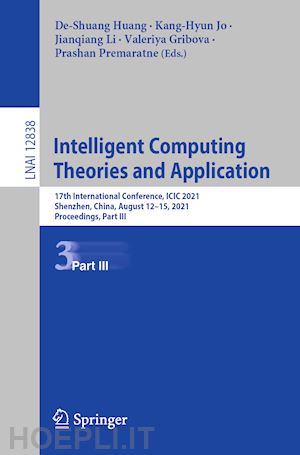

Questo prodotto usufruisce delle SPEDIZIONI GRATIS
selezionando l'opzione Corriere Veloce in fase di ordine.
Pagabile anche con Carta della cultura giovani e del merito, 18App Bonus Cultura e Carta del Docente
The ICIC theme unifies the picture of contemporary intelligent computing techniques as an integral concept that highlights the trends in advanced computational intelligence and bridges theoretical research with applications. The theme for this conference is “Advanced Intelligent Computing Methodologies and Applications.”
The papers are organized in the following subsections: Artificial Intelligence in Real World Applications, Biomedical Informatics Theory and Methods, Complex Diseases Informatics, Gene Regulation Modeling and Analysis, Intelligent Computing in Computational Biology, and Protein Structure and Function Prediction.
Artificial Intelligence in Real World Applications.- Task-oriented Snapshot Network Construction of Stock Market.- Analysis of elimination algorithm based on curve self-intersection.- Towards AI-based Reaction and Mitigation for e-commerce - the ENSURESEC Engine.- Arabic Light Stemmer Based on ISRI Stemmer.- Biomedical Informatics Theory and Methods.- Predicting miRNA-disease associations via a new MeSH headings representation of diseases and eXtreme Gradient Boosting.- Social Media Adverse Drug Reaction Detection based on Bi-LSTM with Multi-head Attention Mechanism.- HOMC: a hierarchical clustering algorithm based on optimal low rank matrix completion for single cell analysis.- mzMD: A new storage and retrieval system for mass spectrometry data.- Drug-target Interaction Prediction via Multiple Output Graph Convolutional Networks.- Inversion of k-nearest neighbours algorithm for extracting SNPs discriminating human populations.- ComPAT: a comprehensive pathway analysistools.- Incorporating Knowledge Base for Deep Classification of Fetal Heart Rate.- Review of methods for data collection experiments with people with dementia and the impact of COVID-19.- KGRN: Knowledge Graph Relational Path Network for Target Prediction of TCM Prescriptions.- Challenges in data capturing and collection for physiological detection of dementia-related difficulties and proposed solutions.- Exploring multi-scale temporal and spectral CSP feature for multi-class motion imagination task classification.- Gingivitis detection by Wavelet Energy Entropy and Linear Regression Classifier.- Decomposition-and-Fusion Network for HE-stained Pathological Image Classification.- Complex Diseases Informatics.- A novel approach for predicting microbe-disease associations by structural perturbation method.- A reinforcement learning-Based model for Human microRNA-disease association prediction.- Delineating QSAR descriptors to explore the inherent properties of naturally occurringpolyphenols, responsible for alpha-synuclein amyloid disaggregation scheming towards effective therapeutics against Parkinson’s disorder.- Study on the mechanism of Cistanche in the treatment of colorectal cancer based on network pharmacology.- A Novel Hybrid Machine Learning Approach Using Deep Learning for the Prediction of Alzheimer Disease Using Genome Data.- Prediction of Heart Disease Probability Based on Various Body Function.- Classification of Pulmonary Diseases from X-ray Images Using a Convolutional Neural Network.- Predicting lncRNA-disease associations based on tensor decomposition method.- AI in Skin Cancer Detection.- MiRNA-Disease Associations Prediction based on Neural Tensor Decomposition.- Gene Regulation Modeling and Analysis.- SHDC: A Method of Similarity Measurement Using Heat Kernel based on Denoising for Clustering scRNA-seq Data.- Research on RNA Secondary Structure Prediction Based on MLP.- Inference of Gene Regulatory Network from Time Series Expression Data by Combining Local Geometric Similarity and Multivariate Regression.- Deep Convolution Recurrent Neural Network for Predicting RNA-Protein Binding Preference in mRNA UTR region.- Joint Association Analysis Method to Predict Genes Related to Liver Cancer.- A Hybrid Deep Neural Network for the Prediction of in-vivo Protein-DNA Binding by combining multiple-instance learning.- Using deep learning to predict transcription factor binding sites combining raw DNA sequence, evolutionary information and epigenomic data.- An abnormal gene detection method based on Selene.- A method for constructing an integrative network of competing endogenous RNAs.- Intelligent Computing in Computational Biology.- Detection of Drug-drug Interactions through Knowledge Graph Integrating Multi-attention with Capsule Network.- SCEC: A Novel Single-Cell Classification Method Based on Cell-Pair Ensemble Learning.- ICNNMDA: An Improved Convolutional Neural Network for Predicting miRNA-disease Associations.- DNA-GCN: Graph convolutional networks for predicting DNA-protein binding.- Weighted Nonnegative Matrix Factorization based on Multi-Source Fusion Information for Predicting CircRNA-Disease Associations.- ScSSC: semi-supervised single cell clustering based on 2D embedding.- SNEMO: Spectral Clustering Based on the Neighborhood for Multi-omics Data.- Covid-19 detection by Wavelet Entropy and Jaya.- An ensemble learning algorithm for predicting HIV-1 protease cleavage sites.- RWRNCP: Random Walking with Restart based Network Consistency Projection for Predicting miRNA-disease Association.- MELPMDA: A New Method Based on Matrix Enhancement and Label Propagation for Predicting miRNA-disease Association.- Prognostic prediction for non-small-cell lung cancer based on deep neural network and multimodal data.- Drug-Target Interactions Prediction with Feature Extraction Strategy Based on Graph Neural Network.- CNNEMS: Using Convolutional Neural Networks to Predict Drug-Target Interactions by Combining Protein Evolution and Molecular Structures Information.- A multi-graph deep learning model for predicting drug-disease associations.- Predicting Drug-disease Associations Based on Network Consistency Projection.- An efficient computational method to predict drug-target interactions utilizing matrix completion and linear optimization method.- Protein Structure and Function Prediction.- Protein-Protein Interaction Prediction by Integrating Sequence Information and Heterogeneous Network Representation.- DNA-Binding Protein Prediction Based on Deep Learning Feature Fusion.- Membrane Protein identification via multiple kernel fuzzy SVM.- Golgi Protein Prediction with Deep Forest.- Prediction of protein-protein interaction based on deep learning feature representation and random forest.-











Il sito utilizza cookie ed altri strumenti di tracciamento che raccolgono informazioni dal dispositivo dell’utente. Oltre ai cookie tecnici ed analitici aggregati, strettamente necessari per il funzionamento di questo sito web, previo consenso dell’utente possono essere installati cookie di profilazione e marketing e cookie dei social media. Cliccando su “Accetto tutti i cookie” saranno attivate tutte le categorie di cookie. Per accettare solo deterninate categorie di cookie, cliccare invece su “Impostazioni cookie”. Chiudendo il banner o continuando a navigare saranno installati solo cookie tecnici. Per maggiori dettagli, consultare la Cookie Policy.